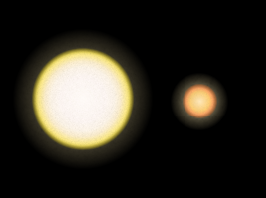Gliese 581
| Observation data Epoch J2000.0 Equinox J2000.0 (ICRS) |
|
|---|---|
| Constellation | Libra |
| Right ascension | 15h 19m 26.8250s |
| Declination | −07° 43′ 20.209″ |
| Apparent magnitude (V) | 10.56 to 10.58 |
| Characteristics | |
| Spectral type | M3V |
| B−V color index | 1.61 |
| Variable type | BY |
| Astrometry | |
| Radial velocity (Rv) | −9.5 ± 0.5 km/s |
| Proper motion (μ) |
RA: −1233.51 mas/yr Dec.: −94.52 mas/yr |
| Parallax (π) | 160.12 ± 1.33mas |
| Distance | 20.4 ± 0.2 ly (6.25 ± 0.05 pc) |
| Absolute magnitude (MV) | 11.6 |
| Details | |
| Mass | 0.31 M☉ |
| Radius | 0.29 R☉ |
| Luminosity (bolometric) | 0.013 L☉ |
| Luminosity (visual, LV) | 0.002 L☉ |
| Surface gravity (log g) | 4.92±0.10 cgs |
| Temperature | 3,480 ± 48 K |
| Metallicity [Fe/H] | −0.33 ± 0.12 dex |
| Rotation | 132.5±6.3 d |
| Age | 7 to 11 Gyr |
| Other designations | |
| Database references | |
| SIMBAD | The star |
| e | |
| b | |
| c | |
| d | |
| f (artifact) | |
| g | |
Gliese 581 (/ˈɡliːzə/) is a star of spectral type M3V (a red dwarf) about 20 light years away from Earth in the constellation Libra. Its estimated mass is about a third of that of the Sun, and it is the 89th closest known star to the Sun. Observations suggest that the star has a planetary system consisting of three known planets, designated Gliese 581 b, c, and e and a possibly confirmed planet, d, in order of discovery. Additional outer planets, which received the designations Gliese 581 f, and g have been proposed, but the evidence that led to the discovery claims has been shown to be the result of stellar activity mimicking the radial velocity variations due to orbiting planets.
Gliese 581 has been the subject of a "huge amount of attention" in the quest to discover the first habitable extrasolar planet; first for c, and then d and g. Gliese 581 c, the first low-mass extrasolar planet found near a habitable zone, was discovered in April 2007. It has since been shown that under known terrestrial planet climate models, Gliese 581 c is likely to have a runaway greenhouse effect, and hence is probably too hot to be habitable, analogous to Venus. The proposed planets Gliese 581 d and Gliese 581 g also received attention as being located within the habitable zone.
...
Wikipedia

